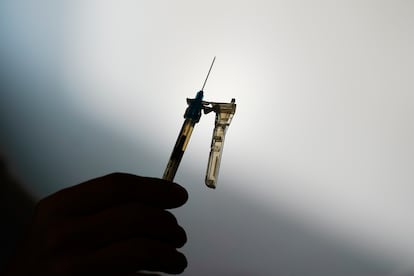To fight cancer, EPA wants sterilizer companies to emit less
The Environmental Protection Agency proposed Tuesday to limit the use of the chemical ethylene oxide

The Environmental Protection Agency proposed Tuesday to limit the use of the chemical ethylene oxide after finding higher than expected cancer risk at facilities that use it to sterilize billions of medical devices each year.
The EPA says its proposal will reduce ethylene oxide emissions by roughly 80% by targeting 86 medical sterilization facilities across the United States. The companies will also have to test for the antimicrobial chemical in the air and make sure their pollution controls are working properly.
“EPA’s number one priority is protecting people’s health and safety,” EPA Administrator Michael Regan said in a statement. “Together they would significantly reduce worker and community exposure to harmful levels of ethylene oxide.”
Darya Minovi, a senior research analyst with the Union of Concerned Scientists, called the action overdue by “almost a decade” and said it should have gone further to require monitoring at facility fence lines so people know what is entering their neighborhoods.
“I’m relieved and pleased that the EPA has finally issued proposed standards that are based on their own scientists’ recommendations on an updated, higher cancer risk value,” said Minovi in a statement.
The tightened safeguards are driven by a better understanding by EPA that ethylene oxide’s threat can be severe. The chemical is classified as a pesticide. A worker in a medical sterilizing plant, over the course of a career, could see his or her risk shoot up by as much as one extra case of cancer for every ten people exposed. The EPA’s generally acceptable increase in lifetime cancer risk is 1 in 10,000.
Ethylene oxide is a gas used to sterilize roughly half of all medical devices and is also used to ensure the safety of certain spices and other food products. It is used to clean everything from catheters to syringes, pacemakers and plastic surgical gowns. Brief exposure isn’t considered a danger, but breathing it long-term elevates the risk of breast cancer and lymphoma, according to the agency.
The EPA said many facilities have already sharply reduced emissions, but those that haven’t will now have to meet stricter requirements.
Scott Whitaker, president and CEO of Advanced Medical Technology Association, said that medical sterilizers provide a vital service and that many devices “cannot be sterilized by another method.” He said the EPA’s risk assessment overstates the threat employees face and undervalues the protections they are already provided.
He added that the facilities are already at capacity and if some close, it could delay medical care. The association said it hadn’t seen any closure announcements yet, but these likely wouldn’t occur immediately. The 18-month timeframe for installing technology to reduce emissions after the final rule is issued is “much too short.”
“It could take many months for abatement equipment to arrive. Supply chains and manufacturing are still recovering from the pandemic,” Whitaker said in a statement.
In Laredo, Texas, residents and activists fought to clean up a sterilization facility run by Missouri-based Midwest Sterilization Corp. It was one of 23 sterilizers in the United States that the EPA said posed a risk for people nearby. Midwest didn’t immediately respond to a request for comment.
“This for us feels like a win,” said Sheila Serna, the climate science and policy director at the environmental group Rio Grande International Study Center. She said despite improvements at the Laredo facility, the risk is still too high. Her group sued the EPA last year, pushing it to tighten ethylene oxide protections. She agreed with Minovi that the proposal should require fence line monitoring as well as protections at warehouses where sterilized products are temporarily stored.
The EPA also wants to require protective vapor masks for people who work with high amounts of ethylene oxide and says some workplaces, including museums, should stop using it altogether because safer alternatives exist.
In recent years, concern over emissions from medical sterilizers has grown sharply. Sterigenics shuttered a medical sterilization plant in a Chicago Suburb after monitoring found emissions spikes in nearby neighborhoods and settled numerous lawsuits.
Tuesday’s proposal follows the EPA’s announcement last week to cut emissions from chemical plants in general to reduce cancer risk. In part, that rule targeted manufactures of ethylene oxide. Tuesday’s proposal targets those who use it.
Sign up for our weekly newsletter to get more English-language news coverage from EL PAÍS USA Edition
Tu suscripción se está usando en otro dispositivo
¿Quieres añadir otro usuario a tu suscripción?
Si continúas leyendo en este dispositivo, no se podrá leer en el otro.
FlechaTu suscripción se está usando en otro dispositivo y solo puedes acceder a EL PAÍS desde un dispositivo a la vez.
Si quieres compartir tu cuenta, cambia tu suscripción a la modalidad Premium, así podrás añadir otro usuario. Cada uno accederá con su propia cuenta de email, lo que os permitirá personalizar vuestra experiencia en EL PAÍS.
¿Tienes una suscripción de empresa? Accede aquí para contratar más cuentas.
En el caso de no saber quién está usando tu cuenta, te recomendamos cambiar tu contraseña aquí.
Si decides continuar compartiendo tu cuenta, este mensaje se mostrará en tu dispositivo y en el de la otra persona que está usando tu cuenta de forma indefinida, afectando a tu experiencia de lectura. Puedes consultar aquí los términos y condiciones de la suscripción digital.
More information
Archived In
Últimas noticias
There is as much life left to discover on planet Earth as that which is already known
Dozens presumed dead, around 100 injured in fire at Swiss Alps bar during New Year’s celebration
Is porn for women different from conventional porn? We spoke to those who make it
Cartagena de Indias is sinking: What can the city do to mitigate it?
Most viewed
- Reinhard Genzel, Nobel laureate in physics: ‘One-minute videos will never give you the truth’
- Sinaloa Cartel war is taking its toll on Los Chapitos
- David King, chemist: ‘There are scientists studying how to cool the planet; nobody should stop these experiments from happening’
- Oona Chaplin: ‘I told James Cameron that I was living in a treehouse and starting a permaculture project with a friend’
- The Interoceanic Train, the Mexican alternative to the Panama Canal










































